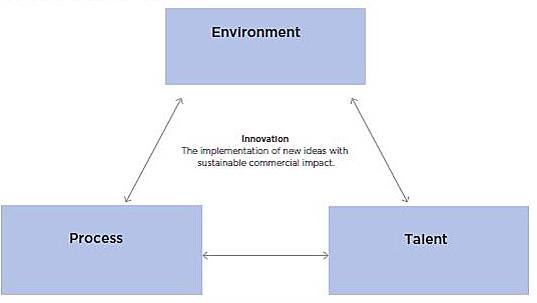If you mention “innovation” to most business leaders, it wouldn’t be a surprise if they begin to think about Tesla, GE, or 3M. Compared to these giants of innovation, continually pushing the bleeding edge of what’s possible through massive investments in research and development, you may feel like innovation is out of reach.
No matter your organization’s size or industry, however, a culture of innovation may be necessary to evolve and succeed in today’s constantly changing business environment.
We see this need for innovation every day. Digital disruption continues to change the way people work. Competitors are constantly on your heels. National and global events affect the way you operate. As the old adage goes, “the only constant is change.”
The Elements of Organizational Innovation
Best practice insight and technology company CEB recently identified three key elements of a culture of innovation, based on their research.

Environment: Giving permission to challenge assumptions, creating openness to new ideas, and giving freedom to experiment, fail, and learn.
Talent: Implementing training and development programs for innovation, setting and managing innovation performance objectives, and building diverse teams.
Process: Considering broad sources for idea generation and having a process to incubate innovative concepts.
Evolving your organization to better balance all three of these elements in a dynamic operating environment is a challenge, however. An organization can institutionalize processes or development programs, but still struggle to provide the right environment to support them. In fact, failure to support innovation most often stems from an organization’s culture rather than some true operational or resource constraint.
According to a 2016 Gartner Financial Services Innovation Survey, “The biggest threat to innovation is internal politics and an organizational culture which doesn’t accept failure, doesn’t accept ideas from outside, and/or cannot change.”
There are leadership challenges to consider as well. Many business leaders don’t recognize their own unconscious beliefs and behaviors that stifle the psychological safety needed for their organization to embrace innovation.
So, where do you start? How can leaders overcome these challenges and move their organizations toward a culture of innovation?
How to Shape a Culture of Innovation
1. Build Clarity and Alignment Around Innovation. Aligning your team around a common definition of the term ‘innovation’ is a first step. What is it? What isn’t it? How do we know we’re successful? Provide a common framework and language around the topic and ensure people understand that innovation is not simply ‘the act of coming up with new ideas’.
2. Create Psychological Safety. Taking an honest look at how people within your organization react to failure can be a very telling factor when innovation is the goal. If the culture of your organization is one that blames, shames and punishes, the chances that people will feel comfortable displaying behaviors other than sheer compliance are slim to none.
3. Encourage Dialogue. Honest and open dialogue can only take place once people feel comfortable to share their true feelings. Bring people together and create space for them to look each other in the eye and talk through their ideas. This will stimulate and reinforce the behaviors necessary to evolve toward an innovation culture.
4. Challenge Your Assumptions. It’s amazing to me how many people operate day-in and day-out using a fundamental set of “rules” that don’t actually exist anywhere. This is often the case, for example, in highly regulated industries where the regulation mindset bleeds over into every decision that is made. Regulations are in place for a reason, but they shouldn’t prevent you from challenging the rules you’ve put upon yourself over the years.
5. Invite Diversity. Bringing together a diverse workforce can really amplify your ability to innovate. In fact, research suggests that having a diverse set of experiences, perspectives, and backgrounds is crucial to innovation and the development of new ideas.
“Embrace the challenge,” says Jonathon Hensley, CEO of Digital Innovation Agency Emerge Interactive. In addition to the tips above, he suggests that leaders must “treat the root cause of a problem as a catalyst of opportunity. Confront your limitations and build innovation competence by identifying what you don’t know, and what must change in order to enable your organization’s success.”
Innovation is not only possible for your organization, it may be necessary if you hope to keep a competitive edge. But innovation only happens when organizations foster a culture where people feel safe to challenge the status quo, dialogue is encouraged, and leaders embrace the challenge.
This article originally appeared on Forbes.

